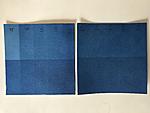Does anyone have any suggestions on finding the base exposure printing time?
I'm trying to find the minimum time for max black as the first step in a more controlled cyanotype process. The method I am following is outlined here:
https://www.timlaytonfineart.com/blo...contact-prints
The other method involves using a Stouffer step wedge which I do not have not do can I readily purchase one.
The print are made using Pictorico OHP film. Paper is Canson Montval with original chemistry.
I am not getting the results that I was hoping for. Adding exposure past 20 minutes does not result in a darker "black". And the black under the OHP film does not match the black without film.
A photo of the test strips is attached.
Any help is greatly appreciated!




 Reply With Quote
Reply With Quote



Bookmarks